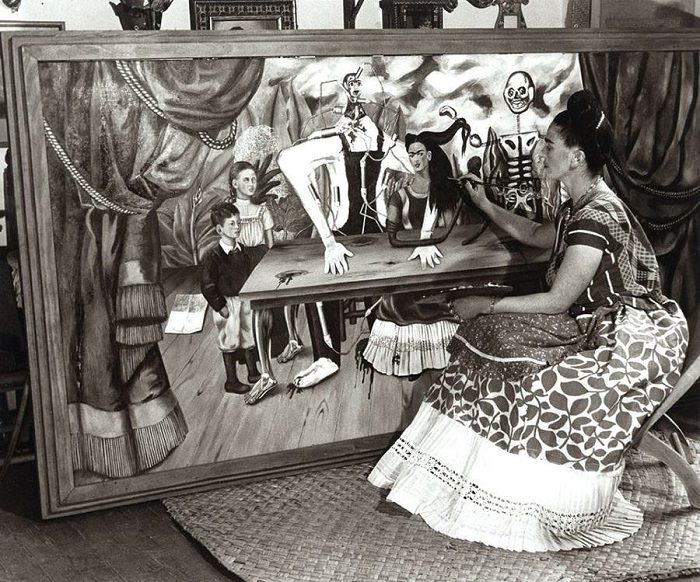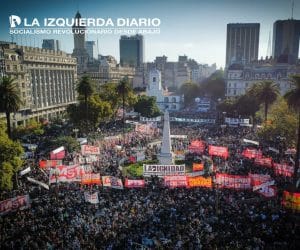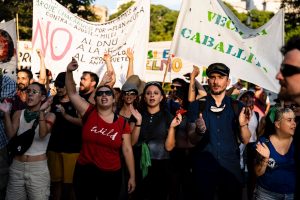It is difficult to approach the life and work of Frida Kahlo through writing. The genius, sharpness and inventive mind she displayed so openly on her canvases evade definitive description. With the stroke of her brush, both the artist and her work became forever embedded in the future, inspiring countless interpretations and narratives even 65 years after her death.
Kahlo has become a mythic figure, her likeness printed on T-shirts and trinkets around the world. Though only a handful of her paintings are well-known, she had a prolific career, producing over a hundred works in her lifetime. Her intimate exploration of the themes of physical and emotional pain as well as love became characteristic features of her body of work and have mesmerized and perplexed viewers for over fifty years. This article interrogates the myth of Frida Kahlo by taking a closer look at aspects of her life and work left underdeveloped in popular depictions, opening one of many windows onto an artistic genius who created an entire tradition in Mexican and Latin American art.
Frida lived, painted and created at the height of the muralist movement of post-revolutionary Mexico, a period which began with the end of the Mexican Revolution in 1917 and lasted until the early 1940s. This time in Mexican history marked the creation of the modern Mexican state, establishing the government and institutions that would give rise to the Institutional Revolutionary Party (PRI) in 1929, a party which dominated Mexican politics for the next 70 years. Though not exactly a muralist herself, Kahlo was deeply ingrained in and influenced by the artistic movement of this political moment, during which time the walls of colonial palaces became canvases for painters’ brushes. However, the muralist movement, like the broader society of which it was a part, was deeply machista; very few women were counted among the great artists of the time. “It is a crime to be a woman and to have talent,” said María Izquierdo, the only female muralist at the time who achieved renown during her lifetime.
Magdalena Carmen Frida Kahlo Calderón was born on July 6, 1907 in Coyoacán, Mexico, into a middle-class family. She was the third daughter of German photographer Guillermo Kahlo and Matilde Calderón y González, who was originally from Oaxaca, Mexico. At an early age, Kahlo contracted polio, a disease that left one of her legs thinner and shorter than the other. As a teenager, she was involved in a bus accident that forced her to have numerous painful surgeries and treatments throughout her life. These early experiences and her long recovery from the bus accident had an indelible impact on her artistic practice and precipitated her first foray into plastic art.

Frida Kahlo: Two Impressions
The art world is notoriously sexist and racist. It is indeed a rare occasion when a woman has her work exhibited in museums around the world. It is even more rare that a Latin American woman’s work would represent an entire epoch.
Frida Kahlo is the exception that proves this rule. Even during her lifetime, she occupied an important place in the artistic and political scene. By the 1940s, she had already exhibited in New York and Paris and was renowned around the world for her work.
Two words begin to describe Kahlo’s work throughout her life: pain and love—continuous pain and love, feelings often connected to the presence of the painter Diego Rivera.
Frida’s body of work took many forms. She created paintings, sculpture and poetry; exchanged letters—primarily with Diego, her lifelong partner, though not her only lover; made artistic interventions on her sick body; and collected photographs and the traditional clothing and handicrafts of various indigenous and Mexican cultures. Both her life and her work articulate a deep sensitivity, an intimate artistic practice and multifaceted identities.
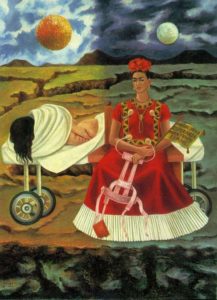
In her work, Frida cuts open and exposes her capacity for vulnerability in love. The most recurrent theme in Kahlo’s personal life is her obsessive love for Diego Rivera, to whom she dedicated innumerable pictorial representations, works which express devotion but also rupture. Selflessness, submission and romantic love are undeniable parts of the story she tells about herself in her poems, paintings and letters.
Diego was a god to Frida, and patriarchal submission and domination were inscribed in their relationship. It is well known that while she professed a deep love and affection for Diego, Frida also accepted Diego’s love on his terms, even when it was deeply painful for her (which it often was). While her artworks focused on her inner experiences, in her relationship with Diego, Frida ceased to be the subject of love and instead became its object, thus reproducing the patriarchal captivity of women. Added to this romantic captivity was the restriction her disabilities placed on her physical freedom; this was one of the many ways in which Diego held power over her throughout her life. This is not meant to gloss over Frida’s artistic achievements or paint either her or Diego as passive participants in their relationship, but rather to unpack the one-sided myth that surrounds Frida; popular oversimplified and romanticized versions of her and Diego’s lifelong partnership ignore the way that patriarchy played a significant role both in their relationship and in their respective bodies of work.
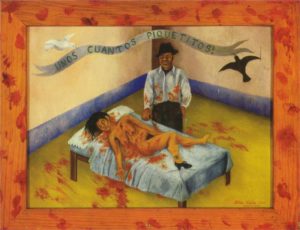
There are of course many more themes in her work. Motherhood, political participation, bisexuality and gender representation also feature heavily in her practice—a patchwork of experiences that, woven together, make up the woman and extraordinary life of Frida Kahlo. While Frida is rightly considered to be disruptive in the boldness with which she exposed her inner truth, this truth also articulates a certain conservatism in the face of patriarchal relationships imposed by society. This conservatism is left out of the myth surrounding Frida; it fails to show how her beautiful art sweetened, with fervor and passion, the relations of patriarchal oppression.
Frida projected her own subjective experience onto every canvas she painted and every poem she wrote, making her personal life public to her viewers. But her creations possess a universal character in additional to the particular: The expression of her identity and political ideology also articulates the collective oppression of women and provides insight into Mexican politics and society.
This confrontation between character and work leaves two distinct impressions on her life and work: one on her own being, expressing what it means to be Frida, and the other on the canvas, challenging the limits of self-portraiture and expression—one on her person and another on her creations.
Personal Stories, Portraits and Paintings
Duality is a constant theme in Frida’s paintings: pain that overtakes life, day versus night. She represents the duality between her pain and her own will, her identity and ideology, and between her personal life and public persona. In this way her works go beyond themselves, turning into real, complex, and sometimes contradictory images of the artist herself. Writer and theorist André Breton called this tendency in her work surrealist and Frida replied: “I paint my own Reality.”
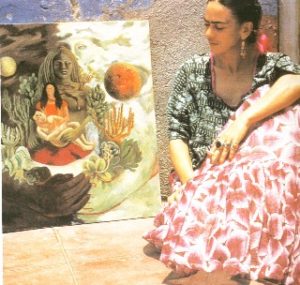
The predominance of the self-portrait, whether in depictions of her travels, her relationship with Rivera, her disability or her Marxist ideology, projects her multifaceted identity and forms an account of her life. The authenticity and strength in Frida’s work that is so difficult to grasp can perhaps be articulated in the inextricably intertwined relationship between her life and work. Her paintings, poems and letters were an extension of her personal transitions and experiences—They were both truth and reality to her.
Person, Context and Politics
Frida also used her body as a canvas, endlessly rewriting her experiences of illness and recovery, repeatedly translating her feelings, emotions and ideals into color and art. The chronic pain she experienced was part of life just like any other feeling and emotion. “Pain, pleasure and death are no more than a process for existence. The revolutionary struggle in this process is a doorway open to intelligence,” she once wrote in a diary.
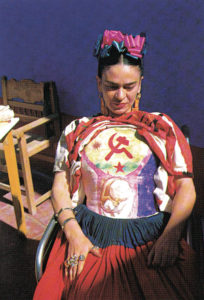
Even during periods of bedrest, when her pain was close to unbearable, Frida never stopped painting. She created artworks out of the plaster corsets which she wore after her accident. She painted the sickle and hammer; flowers and nature; a fetus representing her longing to become pregnant, a desire she could not fulfill as a result of the tram crash in her early life.
Another particularly artistic element of Frida’s personal life was her distinctive and extravagant clothing, a reference to indigenous Mexico. Frida’s art was rooted in the tradition of Mexican muralism, which often depicted nationalist and political messages, constructing a national identity for post-revolutionary Mexico. For Frida, who was also constructing a Mexican identity for herself, indigenous identity was a conscious choice; she wrapped herself in traditional Tehuana clothing, an homage to her mother’s birthplace. Thus Frida’s figure became a reference to her indigenous roots and her quest to personify them became a source of inspiration in her work. In this sense, Frida Kahlo was also part of post-revolutionary Mexico’s emphasis on national identity.
Her politics were significant part of both her daily activities and artistic pursuits. After all, she was a communist who said she was on the side of the oppressed and working class. She painted Karl Marx in her portraits and was instrumental in getting Leon Trotsky asylum in Mexico when no other country would take him.
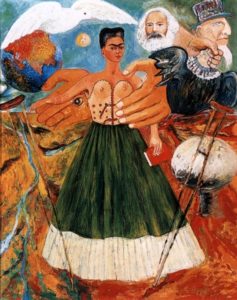
However, her concern with the oppressed and working class is in contradiction with her membership in the Communist Party of Mexico, which was under the leadership of Stalinism. Stalin’s policies led to the collapse of the Russian Revolution of 1917 and his policy of “socialism in one country” reversed the gains of the dictatorship of the proletariat, leading to a series of traitorous and counter-revolutionary politics.
Kahlo was in the Communist Party for much of her life. She joined in 1928 but subsequently resigned when Rivera was expelled from the party after accepting a commission from the Mexican government. She remained involved in politics and both she and Rivera supported Trotsky and the Left Opposition against Stalin. Frida and Diego maintained relations with the Russian revolutionary leader during his exile in Mexico, including the now famous affair between Frida and Trotsky.
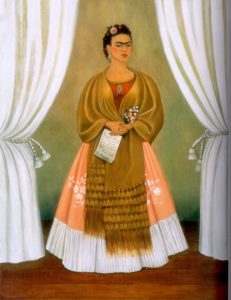
Her close relationship with Trotsky and her political opposition to Stalinism during the 1930s make it all the more surprising that she rejoined the Communist Party in 1948—after the Red Army murdered revolutionaries in the Spanish Civil War, after the Hitler-Stalin pact, after Stalinists attempted to murder Trotsky in his own home and even after an undercover Stalinist agent, Ramon Mercader, murdered Trotsky with an ice pick.
Despite these betrayals, Kahlo remained in the Communist Party. In fact, she wrote in a diary from 1952:
Today I’m in better company than the last 20 years. I am a self and a Communist. I have read that the main origins are wrapped in ancient roots. I have read the History of my country and of nearly all nations. I know their class struggles and their economic conflicts. I understand quite clearly the dialectical materialism of Marx, Engels, Lenin, Stalin and Mao Tse. I love them as pillars of the new Communist world. Since Trotsky came to Mexico I have understood his error. I was never a Trotskyist. But in those days 1940 — my only alliance was with Diego (personally)
This is undoubtedly one of the most contradictory elements in Kahlo’s life: calling herself a communist, but being tied to a counter-revolutionary force. Yet the myth that has built up around her does not include this contradiction; her life is simply remembered as a revolutionary one, a life tied sentimentally to Trotsky.
The Commodification of Frida
Frida Kahlo is undoubtedly Mexico’s most important female artist. She is both an artist and a mythical figure, an icon who traveled the world in life and whose image has traveled even farther after her death. Today, her work sells for millions of dollars in art auctions and produces massive capitalist profits. Her face is plastered on cups, t-shirts and on hundreds of souvenirs in the gift shop of the Casa Azul in Mexico City. These images reproduce a vision of Mexican culture as something exotic and whimsical, hiding the relations of oppression, imperialism and exploitation ingrained in Mexican history. Just as such images obscure the various layers of Frida’s personality and work, they also obscure the social and political conditions of post-revolutionary Mexico that continued oppressive colonial relations with imperialist powers, increasingly and especially the United States.
Her vast body of work and singular personality show Frida Kahlo to be a complex woman and artist. The myth, in contrast, simplifies her work, context and contradictions, emphasizing certain aspects over others, emptying them of their complex content in order to create a product to sell.
Despite her commodification, Frida Kahlo, in all her intricacies and contradictions, is still present in her body of work and in the new interpretations, artworks and readings they inspire even 65 years after her death.
This article will appear in La Izquierda Diario (Mexico). Translated by Tatiana Cozzarelli.


